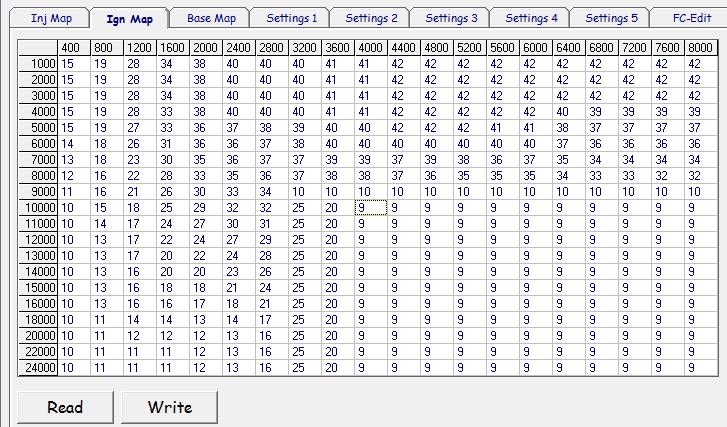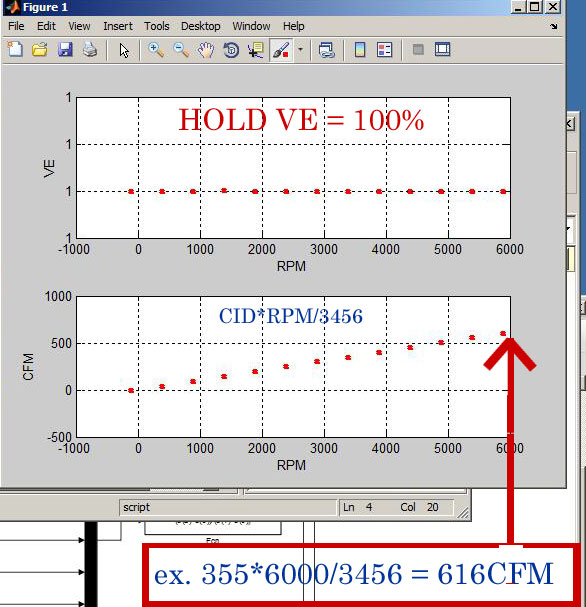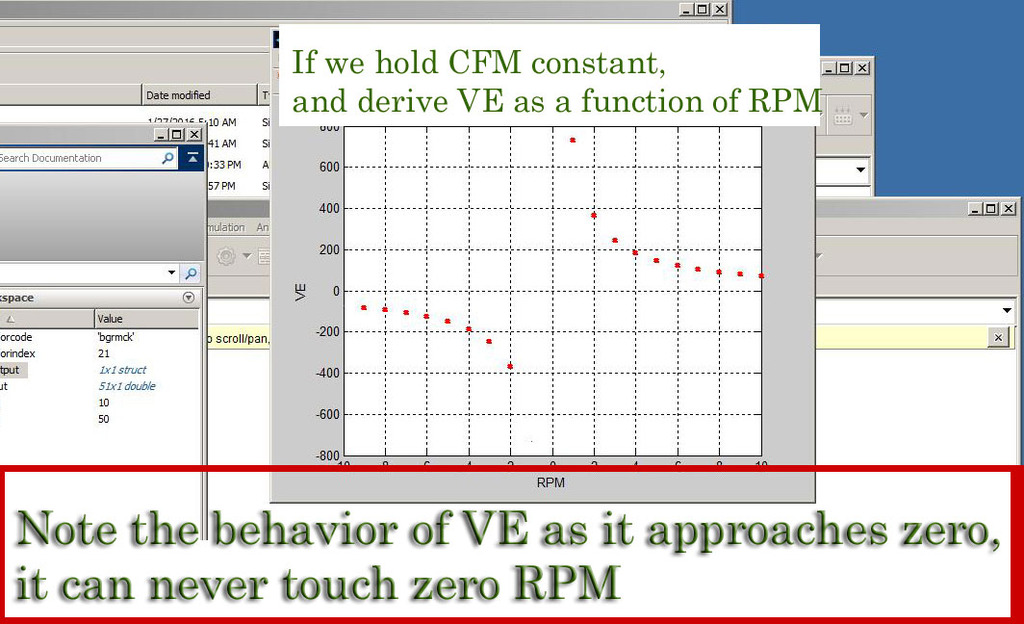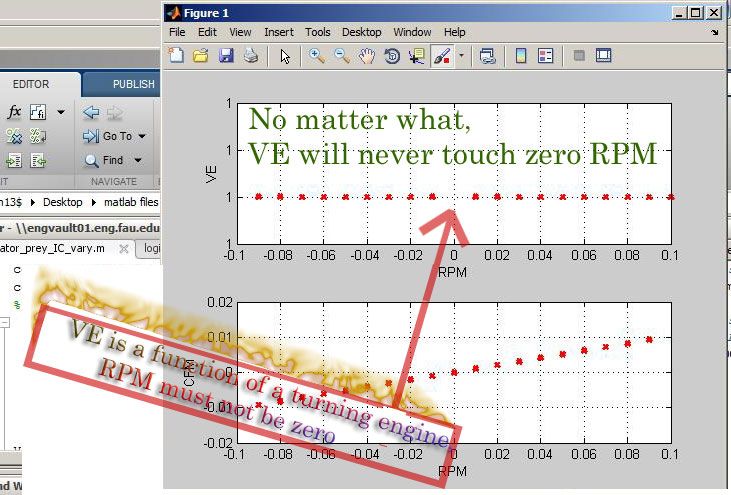A Little Dyno Time Today
#182
Banned
iTrader: (1)
No mistakes. You dont need an electric motor. You can spin the engine by hand. move it 1 revolution per minute and follow the equation I supplied, you will see that VE is SOME NUMBER as long as RPM doesnt equal ZERO. It has nothing to do with torque output. Torque and VE are independent variables.
I used to think they were linked also. I see peak torque and I would say "hey thats peak VE" and its true. But realizing I dont need torque output from the engine to generate volumetric VE made me re-think my logic. Sure you can point and correlate the two; its still a useful tool. But they are completely independent.
#183
TECH Resident
Not much else to say here.....
You might have a career waiting for you as a politician, however don't expect my vote.
You might have a career waiting for you as a politician, however don't expect my vote.
Last edited by ACE1252; 02-27-2016 at 02:31 PM.
#184
Village Troll 

iTrader: (2)
Via PM regarding pics of a project car:
Exactly what kind of work is it you do now? I didn't look at your geocities page, but are there any track times? During the 90's when Talons were a thing to mod I don't believe I ever saw one make a complete pass. Transfer cases were a hot commodity back then. 
Originally Posted by kingtal0n
Not interested in showing them off, I was 17-18 years old (the year was 2001~), $500 budget twin turbos in 2001, its not pretty and nothing compared to what sort of work I do now.
#185
TECH Addict
Via PM regarding pics of a project car:
Exactly what kind of work is it you do now? I didn't look at your geocities page, but are there any track times? During the 90's when Talons were a thing to mod I don't believe I ever saw one make a complete pass. Transfer cases were a hot commodity back then.
Exactly what kind of work is it you do now? I didn't look at your geocities page, but are there any track times? During the 90's when Talons were a thing to mod I don't believe I ever saw one make a complete pass. Transfer cases were a hot commodity back then.
#186
TECH Addict
No mistakes. You dont need an electric motor. You can spin the engine by hand. move it 1 revolution per minute and follow the equation I supplied, you will see that VE is SOME NUMBER as long as RPM doesnt equal ZERO. It has nothing to do with torque output. Torque and VE are independent variables.
I used to think they were linked also. I see peak torque and I would say "hey thats peak VE" and its true. But realizing I dont need torque output from the engine to generate volumetric VE made me re-think my logic. Sure you can point and correlate the two; its still a useful tool. But they are completely independent.
I used to think they were linked also. I see peak torque and I would say "hey thats peak VE" and its true. But realizing I dont need torque output from the engine to generate volumetric VE made me re-think my logic. Sure you can point and correlate the two; its still a useful tool. But they are completely independent.
Now, let's change this up a bit. How does that VE change if we make the pump put OUT power? Would torque be a result of how much air (and therefore fuel) we can get into said pump in a single cycle? If more air = more fuel, does that mean that the more VE we get the more air we get and the more fuel we can burn? And if we have more air and more fuel, do combustion pressures go up (more air/fuel trying to take up the same amount of space)? And if combustion pressures go up, does that put more force on the only moving part of the combustion chamber (the piston)? And if more force is applied to the piston, does that put more force on the crankshaft? And if force on the crankshaft is increased, does that = more torque (force about a rotating axis)? So if we maximize Volumetric Efficiency during a single 4 stroke event, does Torque output also maximize during that same 4 stroke event?
You need to learn how to focus. You got so much conflicting information floating around in your head that you're letting it confuse you (I don't think you realize how confused you are). Think about the topic (that YOU brought up) and what's being discussed (certainly not VE of an air pump being spun by an electric motor), then limit your input to within the perimeters of the discussion. Hopefully input that is correct, but if it's not, that's o.k too; so long as you're willing to accept the corrections brought to you by more knowledgeable people within said discussion, instead of changing the basis of the conversation to fit the comment you provided. For example, if someone asks what does 3+3=, you say 9, we all say no it's 6, then you should say "ohh, my bad". What you are doing right now is saying "well, if you take two 3's and multiply them, they become 9, duh. I mean if you added the 3's together you could say 6, but 3 times 3 is 9, or you could say 3 squared, that works too". It's ridiculous.
Really all you need to do is say to everyone here "I'm sorry for being such a troll, I admit that what I was thinking was wrong and have learned the err of my ways thanks to other, more knowledgeable, members of this conversation. Please accept my sincerest apologies. I look forward to learning more from people here in future discussions and hope that my actions and words here don't reflect our future encounters." Or you can keep on your current path and we'll all remain thoroughly entertained with your amazing amount of "knowledgeable" ignorance.
#187
Banned
iTrader: (1)
when you said this,
I realized you do not posses the mathematical skills to go any further in your current state of education. What you described above is called a linear function, i.e. y=x. That is only one kind of function, and rarely found in nature at that. Y = sin(x) is also a function, a non linear one but still a function. I posted the function for VE and it contains nothing about torque.
Here it is again
VE = (CFM * 3456) / (CID * RPM)
We only need: CFM, CID, and RPM. There is nothing here about engine torque. If you drive along on the highway at 80mph, and shut the key off while the engine is turning, torque output goes to zero and the engine still makes VE because RPM, CID, and CFM is not ZERO.
Furthermore, you can have torque without VE. If you block the engine throttle body so it cannot intake any air, you will have ZERO cfm, and thus zero VE. But I can still make torque by injecting nitrous. Therefore, torque can be made without VE, and VE can be made without torque.
To get a masters in an engineering degree you typically need to experience models that utilize multiple differential equations, this is called modelling and control, and should be a pre-req. It appears you have not gotten that far.
Here it is again
VE = (CFM * 3456) / (CID * RPM)
We only need: CFM, CID, and RPM. There is nothing here about engine torque. If you drive along on the highway at 80mph, and shut the key off while the engine is turning, torque output goes to zero and the engine still makes VE because RPM, CID, and CFM is not ZERO.
Furthermore, you can have torque without VE. If you block the engine throttle body so it cannot intake any air, you will have ZERO cfm, and thus zero VE. But I can still make torque by injecting nitrous. Therefore, torque can be made without VE, and VE can be made without torque.
To get a masters in an engineering degree you typically need to experience models that utilize multiple differential equations, this is called modelling and control, and should be a pre-req. It appears you have not gotten that far.
Last edited by kingtal0n; 02-28-2016 at 05:28 PM.
#188
Banned
iTrader: (1)
Oh and I found a mistake. Well, not a mistake really, just a shortsighted answer on my part. When you decelerate in gear the engine torque output does not go to zero. It goes negative to some negative torque input while VE and RPM and CFM are all above zero (the engine is making VE while torque output is negative) This is similar to turning it by hand, except we are using the road tire drivetrain to spin it "engine breaking". You can open the throttle body and achieve some engine VE, perhaps 80% and more. Using energy from the engine to slow down, just like you can use an exhaust molecule bouncing off the surface of a part to input energy to make something speed up.
Last edited by kingtal0n; 02-28-2016 at 07:50 PM.
#190
TECH Addict
when you said this,
I realized you do not posses the mathematical skills to go any further in your current state of education. What you described above is called a linear function, i.e. y=x. That is only one kind of function, and rarely found in nature at that. Y = sin(x) is also a function, a non linear one but still a function. I posted the function for VE and it contains nothing about torque.
I realized you do not posses the mathematical skills to go any further in your current state of education. What you described above is called a linear function, i.e. y=x. That is only one kind of function, and rarely found in nature at that. Y = sin(x) is also a function, a non linear one but still a function. I posted the function for VE and it contains nothing about torque.
Here it is again
VE = (CFM * 3456) / (CID * RPM)
VE = (CFM * 3456) / (CID * RPM)
As I stated earlier, I don't think you realize how confused you are.
We only need: CFM, CID, and RPM. There is nothing here about engine torque. If you drive along on the highway at 80mph, and shut the key off while the engine is turning, torque output goes to zero and the engine still makes VE because RPM, CID, and CFM is not ZERO.
Don't get me wrong, I know what you're saying. I understand it completely. What I'm saying is that you're wrong as the application of the physics at play are not the same. You're comparing power INPUT VE to power OUTPUT VE, they are not related and the relationship of VE to TQ between the two isn't going to be the same either. The VE of a Turbo compressor vs the VE of an ICE are going to be different for example, because a turbo is driven by an INPUT of power while an engine is driving OUT power.
Furthermore, you can have torque without VE. If you block the engine throttle body so it cannot intake any air, you will have ZERO cfm, and thus zero VE. But I can still make torque by injecting nitrous. Therefore, torque can be made without VE, and VE can be made without torque.
To get a masters in an engineering degree you typically need to experience models that utilize multiple differential equations, this is called modelling and control, and should be a pre-req. It appears you have not gotten that far.
Let's break this down hockey helmet dribble bit for our Engineer to be.
Lets go over some basic understanding of vocabulary. It's obvious you're not ready to practice using those fantastic equations you googled because you don't know how to apply them.
VE = Volumetric Efficiency.
vol·u·met·ric ef·fi·cien·cy
noun
the ratio of the volume of fluid actually displaced by a piston or plunger to its swept volume.
The key word here is RATIO. As soon as you add efficiency to it, you have to have a base number to give a RATIO. Therefore 100% is your base number, in the example of the almighty LT1, we would use 350 cubic inches of displacement (CID). Great, now we know that the LT1's total volume of displacement over a complete 4 stroke event is 350CID. What else we can gather from this is that the other side of the equation has to be in comparison to the base number, you know because it's a RATIO. So, as to your earlier comments of me having to specify what I mean by air intake volume over what event, I don't. The fact that it's VE does it all by it's self.
Next, we'll discuss what was actually said. Not what you think you read. Torque and VE are directly linked. We are also taking about reciprocating internal combustion engines (ICE). So, when VE is discussed in the realm of an ICE and tuning, it is done specifically for fuel tuning with the engine RUNNING. I don't care (nobody does) what the VE of a pump is when it's not doing what it was designed to do. Nobody here said that VE was a RESULT of torque. Nope. What was said was that VE and Torque are directly linked. Peak VE and Peak TQ will correlate with each other.
Now you need to understand why. You can't seem to get this in your head, typical engineering thinking. VE is how much air the engine can take in in relation to it's size during a single 4 stroke event. If you get more VE, you get more air in. We need to meter the fuel (where the actual power comes from) to maintain a certain ratio with the air to maximize it's power potential. The more fuel we burn the more power can be made.
O.k, so, if we want more power, we need more fuel, if we need more fuel, we need more air. AND if more air equals more fuel equals more power, does increasing VE increase power? Well yes and no. Power is work; applying force over time. So time is a consideration of work, you need TIME to do WORK and therefore have POWER. But the other part of the work is force. And force doesn't care about time and that we can directly measure (not calculate like we do with power). So if we increase VE then we increase power over the same amount of TIME, via TORQUE increase. This means that the more efficient an ICE is volumetrically, the more force can be applied, which IS torque when applied to a crankshaft.
What can we deduce from this incredibly hard to understand concept of not even a basic understanding of physics? That TORQUE is a RESULT of VE in a RUNNING ICE. And the higher the VE is the higher the TQ will be.
Now, did you notice I didn't bust out a single equation? It's because they are not needed to understand this phenomenon.
Last edited by hrcslam; 02-28-2016 at 09:11 PM.
#191
Banned
iTrader: (1)
Via PM regarding pics of a project car:
Exactly what kind of work is it you do now? I didn't look at your geocities page, but are there any track times? During the 90's when Talons were a thing to mod I don't believe I ever saw one make a complete pass. Transfer cases were a hot commodity back then.
Exactly what kind of work is it you do now? I didn't look at your geocities page, but are there any track times? During the 90's when Talons were a thing to mod I don't believe I ever saw one make a complete pass. Transfer cases were a hot commodity back then.
#193
TECH Addict
#195
TECH Addict
Originally Posted by kingtal0n
If you lose power, you lose torque or rpm. Not VE.
#196
TECH Resident
Kingtal0n, I don't care how many circles you talk in, you goofed and the bad thing is you know it.
For someone who appears to be working in the field of Bio Engineering, I expect more from you.
For someone who appears to be working in the field of Bio Engineering, I expect more from you.
#197
Banned
iTrader: (1)
Yes and since time was not a part of the equation as it is a constant (the whole ratio thing), the torque must increase to increase power. To increase tq at the same RPM, you must increase VE. Logic, you don't have it. Please, for the love that all is holy, please, I beg you, don't be an engineer.
Also, I can make a timing map that will give peak torque before peak VE.
Last edited by kingtal0n; 02-29-2016 at 04:31 AM.
#199
Banned
iTrader: (1)
Here is a timing map where peak torque will occur BEFORE peak VE.
Peak torque will occur around 3500rpm, and peak VE will occur about 4400rpm (where it always does on the stock engine regardless of torque or timing).

Once the engine passes into the low timing values at WOT, torque will fall, EGT will skyrocket, but the engine will press on (continue to accelerate) and VE will still be good. Torque output is not a direct result of VE but rather a combination of variables.
Peak torque will occur around 3500rpm, and peak VE will occur about 4400rpm (where it always does on the stock engine regardless of torque or timing).

Once the engine passes into the low timing values at WOT, torque will fall, EGT will skyrocket, but the engine will press on (continue to accelerate) and VE will still be good. Torque output is not a direct result of VE but rather a combination of variables.
Last edited by kingtal0n; 02-29-2016 at 04:50 AM.
#200
Banned
iTrader: (1)
I took the time to model VE for you using the math function I posted earlier.
First, here is the traditional method for calculating CFM, that is, RPM*CID/3456 = CFM @ 100% VE. This is to show that my model is working.
For all examples, CID = 355

Next, we look at VE while holding CFM constant to examine the behavior as it approaches zero. Notice VE cannot touch Zero RPM.

And finally, here is a perfect engine, making a perfect 100% VE across the board. Except of course, at zero RPM, where VE can never be anything except undefined. So we can see through these example models that VE is a function of a turning engine, as long as it can move some number of CFM, there will be VE.
Torque plays absolutely NO role, engine can be on or off, it will still make VE at every RPM except zero.

I tutor math (and bio/chem) at my college, you are welcome to stop by anytime for some instruction, or engine tuning, PM for an appointment.
First, here is the traditional method for calculating CFM, that is, RPM*CID/3456 = CFM @ 100% VE. This is to show that my model is working.
For all examples, CID = 355

Next, we look at VE while holding CFM constant to examine the behavior as it approaches zero. Notice VE cannot touch Zero RPM.

And finally, here is a perfect engine, making a perfect 100% VE across the board. Except of course, at zero RPM, where VE can never be anything except undefined. So we can see through these example models that VE is a function of a turning engine, as long as it can move some number of CFM, there will be VE.
Torque plays absolutely NO role, engine can be on or off, it will still make VE at every RPM except zero.

I tutor math (and bio/chem) at my college, you are welcome to stop by anytime for some instruction, or engine tuning, PM for an appointment.
Last edited by kingtal0n; 02-29-2016 at 07:05 AM.




